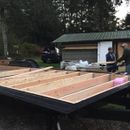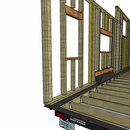Tiny House thermal bridging and condensation nightmare
Help!
I recently completed my tiny house build in which I thought I took comprehensive measures to build a robust system to avoid moisture issues but after living in the house for a few months I am having a huge and unexpected issue.
We have been having water condensing in specific and consistent spots throughout the house. Particularly on the floor perimiter in areas that are within 6 inches of the exterior walls and don’t have ample open air flow. Areas include under cabinets, back of closet, under couch, etc. It even happens in the open when something is left on the floor next to the wall, ie a box, backpack. The moisture is condensing in these places every day and we can’t keep up with trying to wipe up the hard to reach areas, mold is starting to grow. Im incredibly sensitive to mold and we are kind of having a nightmare in our new house to be honest, help!
The house is 24′ long built on an iron eagle trailer. We are in the Pacific Northwest (climate zone 4 C). I highly suspect that we are having major cold spots in these areas because of the trailer design which has a 10″ flange around the perimeter (see pictures) which did not allow for any insulation in these areas. You can see that the subfloor does drop down into the frame which is insulated with rock wool but not around the perimeter. During the build we watched what other people did and it seemed that placing sill seal between the metal and the wall system/sub floor would adequately mitigate the thermal bridging. It certainly was not adequate.
I don’t think there is excessive moisture in the space, none of the windows are condensing except the door. Floors are vinyl plank which seem to stay pretty cold even when the house is hot. Heating is a wood stove.
I am looking for ideas and possible solutions. Hopefully something that doesn’t involve ripping apart the house. So far I am testing an experiment with gluing 2″ rigid foam under the trailer to the metal flanges and adjacent area to help mitigate the thermal bridging. So far it is unsuccessful or not at least not helping enough. We have thought about spray foaming the entire underside of the trailer but especially the perimeter flange cavity. This isn’t totally ideal though because we have bolts fastening the wall system to the trailer that would get covered. We are also considering skirting the house and insulating with rigid foam. Thoughts? Ideas? Thanks!
GBA Detail Library
A collection of one thousand construction details organized by climate and house part













Replies
Have you reduced interior humidity to a measured 30%?
> subfloor does drop down into the frame which is insulated with rock wool
Never use fiber insulation with an exterior side vapor barrier (like steel plate).
That is a pretty ugly detail and a big thermal bridge.
The best would be to pull back the cabinets and wrap the metal sections with a layer of rigid foam and re-install. You want to bring the foam out to enough to fully cover the metal sections. Make sure you air seal well as any air the gets behind the foam can cause condensation issues again.
Another option is spraying the areas with one of the smaller 2 part foam kits. This would do a much better job of sealing things up, getting 2" of SPF on there should stop the condensation. You can then cover the foam with a layer of trim afterwards.
It would be a good idea to this around the whole perimeter but that would effect your finished floor height. Maybe adding in some underfloor heating there could also help. Would be an energy pig though.
gmtinyhouse,
Just to add to what Jon and Akos have said: I don't think there is any point in adding an insulated skirt, unless you were going to heat the entire space under the trailer - which doesn't make much sense. What is causing the condensation is interior air coming in contact with a very cold material (the metal frame). The only purpose of the skirt would be to heat that one flange.
Hi, wondering if you can updated us on how the tiny home is doing and how did you address the problems you were having.
I also wonder where is this tiny home located.
Thanks!
You should read this article on tiny house troubles from the Journal of Light Construction.
https://www.jlconline.com/how-to/insulation/a-troubled-tiny-house_o